
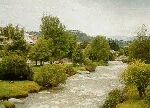
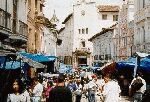
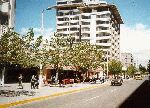
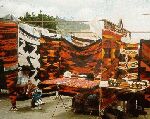

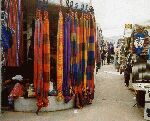
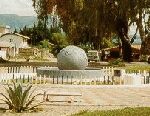
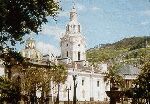
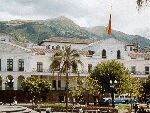

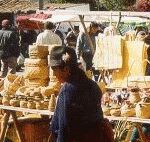
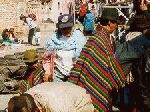
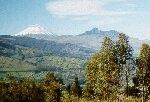
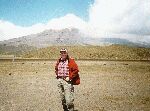
This is an account of my journey through Ecuador in January 1999. I was interested in travelling overland to Ecuador for a few reasons. I had never done a border crossing overland before in this part of the world; it is cheaper than flying; and it was a way of seeing more of the country.
(All the images can be viewed in full by clicking on the thumbnail image.
In order to avoid a very long and boring bus journey travelling north along the Peruvian coastal desert I caught an early morning flight from Lima to Piura and was in the centre of Piura by 9 a.m. From here I took a shared taxi (taxi colectivo) to Sullana (40 minutes) and then another shared taxi to the border at Puente Macará (one and half hours). The taxi colectivo is in common use in South America; they are nearly as cheap as the bus but a lot quicker. Of course, you can't choose who or what you travel with - the one I took to the border had the rear filled to the roof with vegetables. The smell wasn't unpleasant but the vehicle was well down on its rear springs. As we headed towards Ecuador the countryside changed from a flat desert with scrub bushes to green hills covered with forest. The taxi stops 100m short of the border, which is the bridge over the Rio Macará, and from here I had to proceed on foot stopping at the migration office to get an exit stamp in my passport. Then I walked over the bridge, showed my passport to the police post on the Ecuador side then took a pick-up truck in to the town of Macará. I got here just before 1 p.m. so I had time to change some money, have some lunch and then waited until the migration office re-opened at 2 p.m. to get my passport entry stamp into Ecuador.
I then had plenty of time to get the next bus to Loja that left at 3 p.m. This bus journey took nearly five hours over a reasonably good road. The route climbs higher and higher into the hills and by this time the weather had changed to dull and showery. For part of the journey we were in the clouds and couldn't see much at all.
After staying overnight in Loja, the next morning I took a bus (one and half hours) to Vilcabamba. (This village and the surrounding valley are well-known because the inhabitants of the area are reputed to live to a very old age.) The valley itself is very pleasant (rather like the English Lake District with tropical vegetation) and there is a lot of opportunity to go hiking and pony-trekking. Unfortunately, there were frequent rain showers and since there isn't much else to do in Vilcabamba I decided to stay only one night.
Next morning I returned to Loja by taxi colectivo and then took the bus to Cuenca (five and a half hours). The journey would have been much quicker if the asphalt road surface had been maintained; it was a continual succession of pot-holes and the bus just crawled along dodging the worst of them. The countryside was pleasant with high hills and deep valleys and many small farms.
Cuenca is a very pleasant town with old colonial architecture and cobbled streets and a river running through the centre. I had intended to do a trip to a National Park nearby but I was struck down with the Cuenca quickstep and had to stay very close to a toilet for twenty-four hours. It was here that I read in the local paper that there were strikes, demonstrations and road-blocks against the worsening economic situation planned for the following week. I had planned to continue northwards to Quito by bus in stages but I decided to cut out the next part of my tour and instead took a short flight from Cuenca straight up to Quito.
Quito is much nicer than Lima; the altitude is around 2800 metres so the climate is spring-like the whole year round and the population is about one-fifth that of Lima. The old city has the same colonial architecture and cobbled streets as Cuenca, while the new city has well-designed modern buildings. The bus system is easy to use and there is also a trolley bus line. I stayed here four nights and explored the city both by day and night.
While I was there I took a tour by bus to the north of Quito to see the famous market of Otavalo, the main feature of which is the bright and colourful local weavings. There are also many other handicrafts on sale including lace cloths, alpaca wool sweaters and Panama hats. The tour crosses the Ecuator where there is a small monument by the roadside and where, if you are feeling perverse, you can stand with one foot in either hemisphere and the Ecuator running between your legs. Volcanoes dominate the scenery round about most of which are extinct. We also stopped in a town called Cotacachi where every shop was given over to selling leather clothes and goods of all kinds at really cheap prices.
I found Ecuador to be quite a lot cheaper than Peru. Outside Quito I was able to get a nice room with private bath and TV in a centrally located hotel for between $5 and $6, and in Quito for $9 per night. When I worked out the cost of bus travel I realised it costs $1 for every hour of travel. Quito is also the main Spanish language learning centre of the continent and there are many inexpensive schools of good standard.
A pocket calculator is a useful accessory to have in Ecuador. The rate of exchange on this visit was 7200 Sucres to one dollar so it became necessary to think in big numbers and to get the number of zeros correct. As I re-edit this in August 2000 the currency of Ecuador is now U.S. dollars. The former currency of Sucres is being replaced and by September 2000 the change-over should be complete. However small change is still given in Sucres and the exchange rate is $1 = 25,000 Sucres.
I returned to Peru by taking an overnight bus from Quito to the border at Huayquillas - a journey of fourteen hours. The bus was air-conditioned and comfortable enough but when we got to the migration office 2 kilometres short of the border I received a surprise. All the gringos were thrown off the bus and told the bus couldn't wait for us and left us all there. Getting the exit visa took only a few minutes then we had to take a taxi for the rest of the way. Crossing the border involves walking down a narrow street of the busy town until you cross a bridge at which point you are in Peru. All the time you are being hassled by money-changers, taxi drivers and other unpleasant people looking for ways to rip-off the unsuspecting gringos. I joined forces with some others and we shared a taxi to the Peruvian migration office, which is 3 kilometres inside the border. After that we continued on to Tumbes which is the first major town in Peru.
I returned to Ecuador in June 2000 by air from Lima to Quito and stayed there for two weeks researching information for another web-site. While there I did a one day-trip out of Quito about two hours drive south of the city along the valley of the volcaoes where first I was taken to a large and very colourful native market at Saquisili, then after that to the Cotopaxi national park on the slopes of the snow-covered volcano Cotopaxi (5900m).
Now carry on travelling to -
Bolivia
Lima
Huancayo
Train
Amazon
Rainforest
Chachapoyas